
Kathmandu, officially Kathmandu Metropolitan City, is the capital and most populous city of Nepal with 845,767 inhabitants living in 105,649 households in 2021 and 2.9 million people in its urban agglomeration. It is located in the Kathmandu Valley, a large valley in the high plateaus in central Nepal, at an altitude of 1,400 metres.
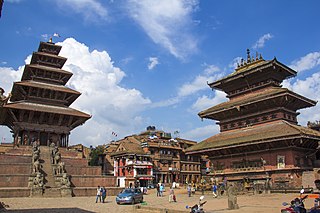
Bhaktapur, known locally as Khwopa and historically called Bhatgaon, is a city in the east corner of the Kathmandu Valley in Nepal located about 13 kilometres (8.1 mi) from the capital city, Kathmandu. Bhaktapur is the smallest city of Nepal as well the most densely populated. Along with Kathmandu and Lalitpur, Bhaktapur is one of the three main cities of the Kathmandu Valley and is a major Newar settlement of the country. The city is also known for its Newar tradition, cuisine and artisans. Bhaktapur suffered heavy damage in the April 2015 earthquake.

Newar or Newari, known officially in Nepal as Nepal Bhasa, is a Sino-Tibetan language spoken by the Newar people, the indigenous inhabitants of Nepal Mandala, which consists of the Kathmandu Valley and surrounding regions in Nepal.

The Kathmandu Valley ; also known as the Nepal Valley or Nepa Valley, is a bowl-shaped valley located in the Himalayan mountains in Nepal. It lies at the crossroads of ancient civilizations of the Indian subcontinent and the broader Asian continent, and has at least 130 important monuments, including several pilgrimage sites for Hindus and Buddhists. There are seven World Heritage Sites within the valley.

The Malla dynasty was the ruling dynasty of the Kathmandu Valley in Nepal from 1201 to 1779. They were a Raghuvanshi dynasty who were seen as the descendants of the Licchavi dynasty. Later Malla kings also traced one section of their lineage from Nanyadeva, the founder of the Karnat dynasty of Mithila. The term malla means wrestler in Sanskrit. The first use of the word malla in the Kathmandu Valley begins from 1201. The Malla period was a golden one that stretched over 600 years, as they presided over and flourished the Newar civilization of Nepal Mandala which developed as one of the most sophisticated urban civilisation in the Himalayan foothills and a key destination in the India-Tibet trade route.

Nepali architecture or Nepalese architecture is a unique blend of artistic and practical considerations. Situated between the trade routes of India, Tibet and China, Nepali architecture reflects influences from these cultural strongholds. The pagoda architectural tradition figures prominently among Hindu temples in the country. In contrast, Buddhist temples reflect the Tibetan tradition of Buddhist architecture and the stupa features prominently. Mugal, summit and dome styles also have great scope in Nepal. Whilst significant influence for Nepal's architecture comes from India, there is also a distinct influence from the Newar people.

Bandipur is a hilltop settlement and a rural municipality in Tanahun District, Gandaki province of Nepal. Bandipur is primarily known for its preserved, old time cultural atmosphere. At the time of the 2011 Nepal census it had a population of total 15,591 people living in 3,750 individual households.

A dhunge dhara or hiti is a traditional stone drinking fountain found in Nepal. It is an intricately carved stone waterway through which water flows uninterrupted from underground sources. Dhunge dharas are part of a comprehensive drinking water supply system, commissioned by various rulers of Ancient and Medieval Nepal. The system is supported by numerous ponds and canals that form an elaborate network of water bodies, created as a water resource during the dry season and to help alleviate the water pressure caused by the monsoon rains. After the introduction of modern, piped water systems, starting in the late 19th century, this old system has fallen into disrepair and some parts of it are lost forever. Nevertheless, many people of Nepal still rely on the old dhunge dharas on a daily basis.

The Newar language of Nepal has the fourth oldest literature tradition among the Sino-Tibetan languages.

Nuwakot (नुवाकोट) is one of the district in midwest Nepal. The city is located on the bank of Trishuli and Tandi Rivers. It is Located just 75 km west from Kathmandu, known as historic town which was the capital of the Valley in the days before the unification of Nepal by Prithvi Narayan Shah, and for more than 1,000 years the hilltop had served as a lookout and fort (kot) guarding the western entrance to Kathmandu Valley. Nuwakot served as an important trading hub for the Malla kings of the Valley, and was along a major transit route used for trade between India and Tibet. Making the Nuwakot hill as main forts including other eight forts: Malakot, Simalkot, Bhairabkot, Belkot, Kalikot, Salyankot, Dhuwankot and Pyaskot in its surrounding area, collectively named as 'Nawakotta'.

Bajrayogini Temple(Nepali: बज्रयोगिनी मन्दिर) is a Tantric Buddhist temple located at Sakwa in Nepal's Kathmandu Valley. It is also well known as Bodhisattva's Temple. The temple is actually a sort of temple complex, with the main temple having been built by King Pratap Malla in the sixteenth century. Vajrayogini is a Buddhist tantric deity, she is also conflated with Ugra Tara, a form of the Buddhist dharmapala Ekajati. However, the temple is sacred to both Buddhists and Hindus.
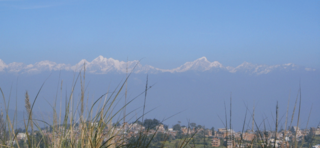
Dhulikhel is a municipality in Kavrepalanchok District of Nepal. Two major highway B.P. Highway and Arniko Highway passes through Dhulikhel. Araniko Highway connects Kathmandu, Nepal's capital city with Tibet's border town of Kodari. Dhulikhel is located at the Eastern rim of Kathmandu Valley, south of the Himalayas at 1550m above sea level and is situated 30 km southeast of Kathmandu and 74 km southwest of Kodari. The Majority of people in Dhulikhel are Newars, and Brahmin, Chhettri, Tamang and Dalit are also living in outer area of the town. Drinking water in Dhulikhel is some of the best water in Nepal. It was made with the help of the German NGO German Technical Cooperation.

Madhyapur Thimi, also known as Thimi, is a municipality in Bhaktapur District in the Bagmati Zone of central Nepal. Thimi lies between Kathmandu, Lalitpur and Bhaktapur in the Kathmandu Valley. It is one of the ancient cultural and historical places along the trade route from Bhaktapur to Kathmandu. The city is situated on elevated land and occupies an area of 11.47 square kilometres (4.43 sq mi), divided into nine administrative wards.
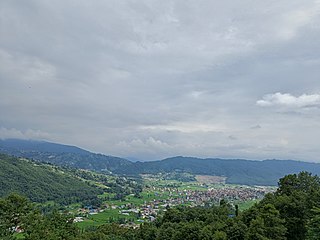
Sankhu (साँखु) is the ancient Newar town located in the north-eastern corner of Kathmandu Valley which is about 17 km from the city center of Kathmandu. Sankhu was formerly divided into three Village Development Committee, namely, Pukhulachhi, Suntol and Bajrayogini. Recently the town of Sankhu has been declared as Shankharapur Municipality merging three above-mentioned VDCs and other neighbouring VDCs. At the time of the 2011 Nepal census it had a population of 4333 living in 928 individual households. Sankhu lies between river Salinakhu in east and Asakhu in the west.

The ancient and refined traditional culture of Kathmandu, for that matter in the whole of Nepal, is an uninterrupted and exceptional meeting of the Hindu and Buddhist ethos practiced by its highly religious people. It has also embraced in its fold the cultural diversity provided by the other religions such as Kirat, Jainism, Islam and Christianity.

Bhaktapur Durbar Square is a former royal palace complex located in Bhaktapur, Nepal. It housed the Malla kings of Nepal from 14th to 15th century and the kings of the Kingdom of Bhaktapur from 15th to late 18th century until the kingdom was conquered in 1769. Today, this square is recognised by UNESCO managed jointly by the Archeological Department of Nepal and Bhaktapur Municipality and is under heavy restoration due to the damages from the earthquake in 1934 and the recent earthquake of 2015.
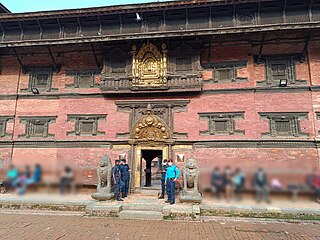
Patan Durbar Square(Nepal Bhasa:𑐫𑐮 𑐮𑐵𑐫𑐎𑐹/यल लायकु, Nepali: पाटन दरवार) is situated at the centre of the city of Lalitpur in Nepal. It is one of the three Durbar Squares in the Kathmandu Valley, all of which are UNESCO World Heritage Sites. One of its attractions is the ancient royal palace where the Malla Kings of Lalitpur resided.

Pratap Malla was a Malla king and the eighth King of Kantipur from 1641 until his death in 1674. He attempted to unify Kathmandu Valley by conquering Lalitpur and Bhaktapur, but failed in the effort. He was successful in extending and securing the borders of Kantipur and was responsible for the monopoly over trade with Tibet. The resulting prosperity was responsible for the construction of majority of the buildings around Durbar Square during his reign. His reign is seen as a cultural and economical high point of the Malla dynasty.
The Kathmandu Valley Preservation Trust (KVPT) is an independent organization working to safeguard the historic architecture of the Kathmandu Valley in Nepal. KVPT was founded in 1991 by architectural historian Eduard Sekler, then team leader of the UNESCO Campaign to Safeguard the Cultural Heritage of the Kathmandu Valley, and is run by a team of Nepali architects and craftspeople in Patan, working closely with the Government of Nepal, Department of Archaeology. Over the past two decades, KVPT has saved over 50 buildings throughout the valley including rest-houses, temples, monasteries, stepwells, palaces and homes. Seismic retrofit is an important component of almost every restoration project. Since 2006, KVPT has been working primarily on the complete restoration and adaptive re-use of the abandoned palace complex adjoining Patan Durbar Square.
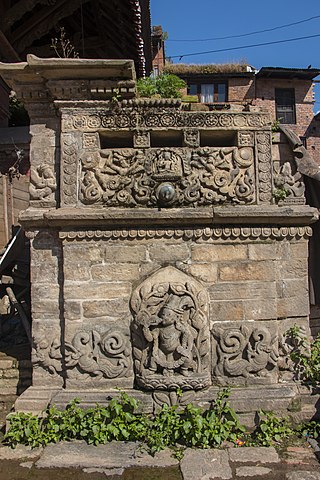
A tutedhara (Nepali) or jahru (Newari) is a traditional drinking fountain found in Nepal. It is a water reservoir built out of stone with a tap that can be opened and closed. These structures are either free-standing or integrated into the wall of another building. They depend on a water well or a dhunge dhara to be filled. Only a few of them are in use today, but some of the stone parts have been put to other uses, and there are contemporary equivalents. The best known tutedhara is the one built into a wall in the royal palace on Kathmandu Durbar Square. It is inscribed with a poem dedicated to the goddess Kali, written in fifteen different languages.





















